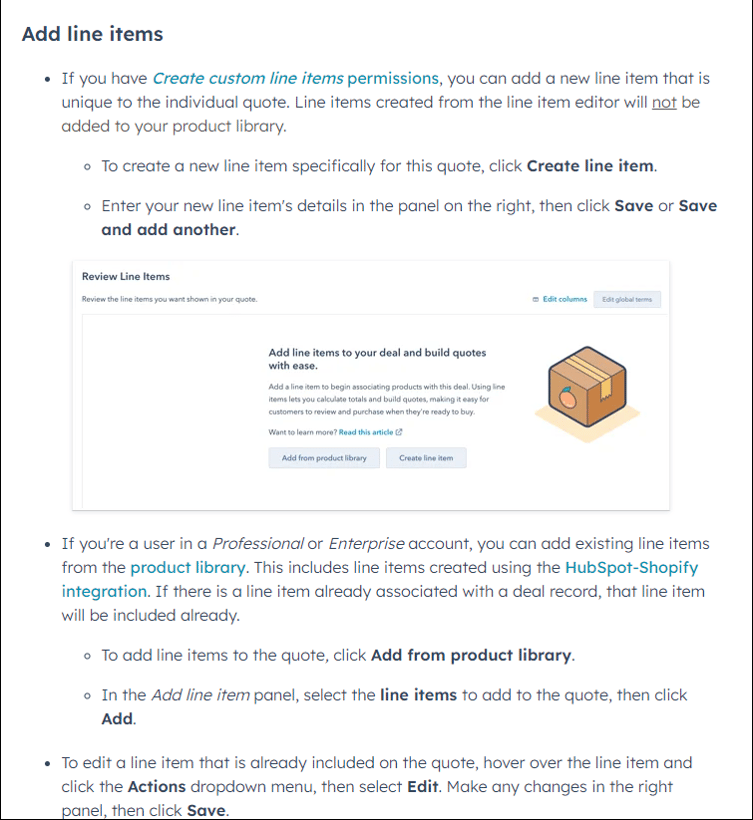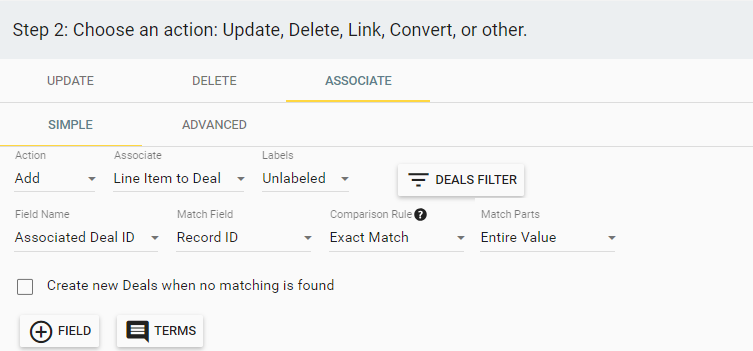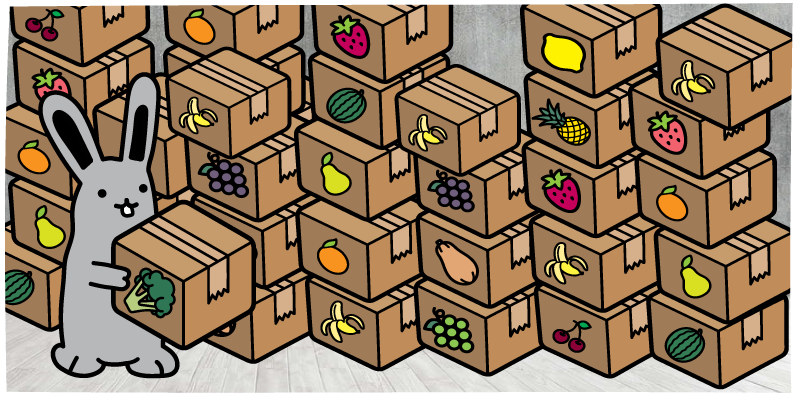For companies, the ability to track and manage detailed transaction data is crucial. There is no data more valuable than your customer data, and data concerning the deals that your company closes is a potential treasure trove of information—but only if you are set up to track it efficiently. To do that, you need specific, segmentable sales data that is appropriately connected to the contact and company records in your CRM.
HubSpot, a leading CRM platform, recognized this need and introduced line items for deals and quotes into its system. Previously, companies could create deals in HubSpot, which would then be associated with the correct company in their system. However, they did not have granular control of line items. This limited their ability to segment their deals by specific purchases—and better understand the behavior of their customers. Companies lacked the ability to record what clients were purchasing line by line, so they were missing the opportunity for valuable analysis.
Line items allow for detailed tracking of each product or service involved in a deal, enabling businesses to use HubSpot payments effectively, provide accurate quotes, and offer their finance teams improved access to data. For instance, a home services company could break down its services into line items such as “Plumbing Repair,” “Electrical Installation,” and “Roofing Services,” along with the associated sub-services and their respective pricing and quantity. This level of detail can lead to more transparent negotiations and improved customer relationships.
The line items feature is a significant step forward. It allows businesses to break down their deals into individual components or services and provides a granular view of what customers are buying, transforming the way businesses handle their sales processes within HubSpot.
But making use of this new feature requires changes—changes to the way that deals are created in the system and alterations to internal processes and documentation. Companies also need to adjust automations and other data architecture decisions within HubSpot CRM to integrate line items into their existing processes for creating and using deal records within the system.
Let’s examine some of the specific issues surrounding line items and how they impact the companies that use them.
The Issues and Impact of Inefficient Line Item Management
Significant changes are necessary to effectively use the new line items feature. Companies that try to make them often run into several major roadblocks:
- Line item management requires a lot of manual work which hurts productivity.
- Line items and products in HubSpot are similar but different, which causes confusion that leads to errant quotes and hurts productivity.
- A lack of automation options for line items means they require manual management and monitoring.
- Finding apps that integrate smoothly with line items isn’t easy and can create its own problems.
Let’s dig deeper into these issues.
HubSpot Line Items and Manual Work
HubSpot line items require a significant amount of manual work to use effectively. There is no simple, automatic way to add line items to deals based on rules.
This manual work can become a bottleneck in your sales process, slowing down deal closure and impacting your team's productivity. And companies that have typically automated their processes may find that their teams push back if they try to adopt line items and upset those familiar procedures.
For example, imagine a scenario where, each time a new deal is created, a sales rep has to manually add each line item relevant to that deal. This process can be time-consuming, especially for businesses with a large product or service catalog.
Similarly, updating quantities for line items is also a manual process that falls on sales reps. This increases the workload for the sales rep and leaves room for human error.
For companies that want to use HubSpot’s quoting features in their sales processes, line items are a necessity. While you can manually create line items for use on the quote, these line items only apply directly to the quote you create them on, and are not added to your product library. This means that you cannot update the line item in your product library to change the description or price and have it reflected across all active quotes. For more information on line items and quotes in HubSpot, check out their quoting documentation.

Line Items vs. Products and the Confusion Surrounding Them
Two key features of HubSpot's sales software are "Products" and "Line Items," and understanding the difference between them can sometimes be confusing. Here's a brief explanation:
- Products: In HubSpot, a product represents a good or service that your company sells. You can create a product library in HubSpot where each product has specific properties such as name, price, description, and SKU. This product library can be used across multiple deals, quotes, and invoices. Essentially, products are the items that your company offers to customers.
- Line items: A line item, on the other hand, is a specific instance of a product that is associated with a deal, quote, or invoice. When you add a product to a deal, quote, or invoice, it becomes a line item. Each line item can have its own quantity, discounts, and custom properties. In other words, line items are the specific instances of products in a transaction.
Confusion often arises because these terms are used interchangeably in many other contexts. However, in HubSpot, they have distinct meanings. A product becomes a line item when it is added to a deal, quote, or invoice. The product is the general offering, while the line item is the specific instance of that product in a transaction.
It's also worth noting that, while you can edit product details in the product library and have those changes reflected in future deals, changes made to line items in a deal do not affect the original product in the product library. This allows for customization and flexibility in individual deals, but can also contribute to the confusion between the two terms.
Automation Limitations
Another significant issue can occur when there are no tools to manage line items in bulk or to update them automatically through Workflows. When businesses manage a high volume of deals but aren’t able to assign line items based on predefined rules, inconsistencies can arise. Keeping things moving forward then requires a lot of manual work.
Additionally, HubSpot line items come with limitations on automation. While line items can be automatically added to new deals, it's not possible to update line items in Workflows. So while a line item can be added to a deal, any customization of that line item needs to happen manually. That is a severe roadblock hampering the insertion of line items into existing processes—and is one of the big reasons that adopting line items in HubSpot is too big of a hassle for many companies.
Without Workflow automation, using HubSpot’s line items means adopting the manual management processes that come with it.
Integration Challenges
Integrating line items with third-party apps can also present challenges. While some apps do integrate with line items, they often have their own considerations that you’ll need to understand to use them effectively.
Often, line item challenges arise as a result of integration problems between HubSpot and e-commerce app integrations. Deals are typically associated with orders and line items represent the products purchased in the order. But often, discrepancies can arise due to quirks in the way the apps share data with HubSpot. For instance, if a product's price is updated in the e-commerce platform, but not in HubSpot, the line items may not be updated for the new pricing, causing inaccurate quotes and billing issues.
Often, companies may find that some aspects of line items have been fully integrated with other apps, while a few overlooked quirks create inconsistencies between the platforms.
These challenges can affect sales efficiency, customer relationships, and ultimately, a company’s bottom line.
How Companies Are Working Around These Issues
Companies deal with the aforementioned issues differently, depending on the specific issues that they experience. However, many companies end up doing one of the following things:
- Manual line item management: Some businesses resort to manually creating and updating line items for each deal. This approach, while time-consuming, allows for a high level of customization. However, it can lead to inconsistencies and errors, especially when dealing with a large number of deals or products.
- Avoiding line items altogether: Some businesses choose to avoid using line items altogether due to the challenges associated with their management. This approach, however, can lead to a lack of granularity in deal data and an inability to use HubSpot’s quoting system effectively.
- Third-party integrations: Some businesses use third-party integrations to manage line items. However, because the line items feature is newer and not as widely used as other features, it can be difficult to find integrations to help you manage it.
For companies that depend on line items, there aren’t many good options available. They are forced to either deal with the quirks of using them—or avoid using them altogether.
Unless they use Insycle.
Insycle: HubSpot Line Item Management and Headache Cure
Insycle is a data management solution that offers a comprehensive way to manage HubSpot line items efficiently, addressing many of the pain points that businesses face.
Bulk Analysis and Operations
One of the primary challenges businesses encounter when managing line items in HubSpot is the inability to perform bulk operations. Insycle addresses this by providing a robust system for bulk analysis of line items. This feature allows businesses to perform advanced segmentation and data slicing, enabling them to manage large volumes of line items with ease.
First, you filter your records.

Then, Insycle generates a preview of all of the data that meets your specifications.

Then, with this information, you can further refine your filter or make changes directly to the data.
Quick Updates With Grid Edit
Another significant issue businesses face is the manual work required to update line items. You can make quick updates using Insycle’s Grid Edit module, which offers a system similar to Excel for segmenting and editing line items. This feature can be a game-changer for businesses that deal with a large number of line items, significantly reducing the manual work involved in their management.

Bulk Association of Line Items to Deals
Insycle also addresses the challenge of associating line items to deals, allowing you to do so in bulk with predefined rules. This is particularly useful for businesses that frequently add new products or services to their offerings.

Copying Values From Deals to Line Items
One of the unique features of Insycle is its ability to copy values from deals to line items quickly and easily. This feature streamlines the data management process, ensuring that the information in deals and line items is always in sync.
Then, you could use the copied values in other processes, such as deduplication or association.

Line Items and Products
Insycle can help you edit individual line items or the broader product that they are derived from. This gives you complete control over your line items in the past, present, and future.
Case Study: How Ciirus Used Insycle To Streamline Line Item Management and Shift to Revenue-Prioritized Sales Process
Ciirus, a rental property management software company, works with professional property managers to manage their business operations and inventory across all major platforms. As part of its growth strategy, the company decided to pivot to a revenue-focused prioritization for its sales teams. However, Ciirus quickly realized that its current system was not equipped to handle this shift efficiently.
The Challenge: Ciirus Needed Line Item Quantities To Update Automatically
Ciirus had workflows in place to add line items automatically, but updating line item quantities was a manual process. This lack of automation meant that its sales team had to spend valuable time on data entry tasks, which was not an efficient use of its resources.
Moreover, without line items, Ciirus had limited visibility into the lower end of its sales pipeline and the top of the sales funnel. The team couldn't clearly see the revenue potential of each deal, which made it difficult to prioritize sales efforts effectively.
Another significant stumbling block was the inability to use quotes effectively. Line items feed into quotes, providing customers with a detailed rundown of what they're getting. However, without efficient line item management, Ciirus was unable to leverage this feature to its full potential.
The Solution: Use Insycle To Update Line Item Quantities in Bulk, Based on Rules
While searching for a solution to these challenges, Ciirus discovered Insycle. With Insycle, the team was able to quickly update quantities for line items based on a custom value held in the deal field. This automation saved the sales team time and made the process less error-prone.
With Insycle, Ciirus was able to implement a workflow where, after a form is filled out, the corresponding line items, quotes, and deals are updated. This streamlined process provided a clear view of the revenue potential of each deal, enabling the company to prioritize its sales efforts effectively.
The Impact
The impact of implementing Insycle was immediate and significant. Ciirus was able to shift the responsibility of line item management from the sales team to Insycle, freeing up the sales team to focus on what they do best: closing deals.
Moreover, with the ability to use quotes effectively, Ciirus was able to provide customers with a clear rundown of what they were getting. This transparency improved customer relationships and helped to close deals more effectively.
By streamlining line item management with Insycle, Ciirus was able to shift to a revenue-prioritized sales process. This shift saved time on manual data entry and made its sales operations more efficient, allowing reps to close more and better deals.
Insycle: A Comprehensive HubSpot Solution
Insycle is a clear, effective solution for companies that need help with HubSpot line item management. Whether you want to analyze your existing line items, automatically update line items and products in bulk, or share data between deals and line items, Insycle can help.
More Than Just Line Item Management
But the benefits of Insycle extend beyond line item management. As a complete HubSpot data management solution, Insycle can help businesses optimize their use of the HubSpot platform. From managing contacts and companies to deals and tickets, Insycle provides a range of features that can streamline your sales and marketing processes—including deduplication, standardization, auditing, formatting, associations, and importing.
Ready To Transform Your HubSpot Data Management?
If you're struggling with managing line items in HubSpot, or if you're looking for a way to optimize your use of the HubSpot platform, consider giving Insycle a try. With its robust features and user-friendly interface, Insycle can help reshape your HubSpot data management processes. Learn why Insycle could be the tool you need to transform your HubSpot data management.






